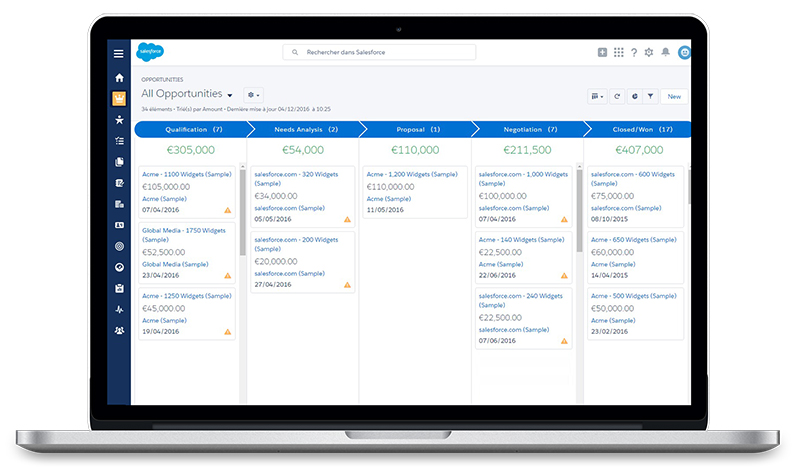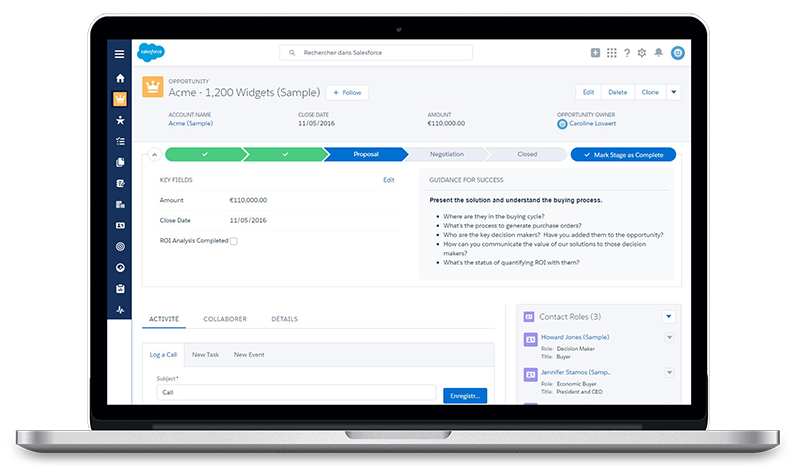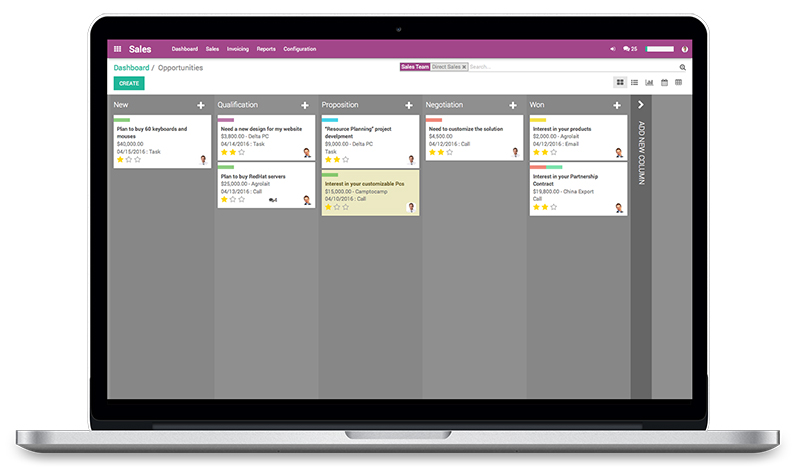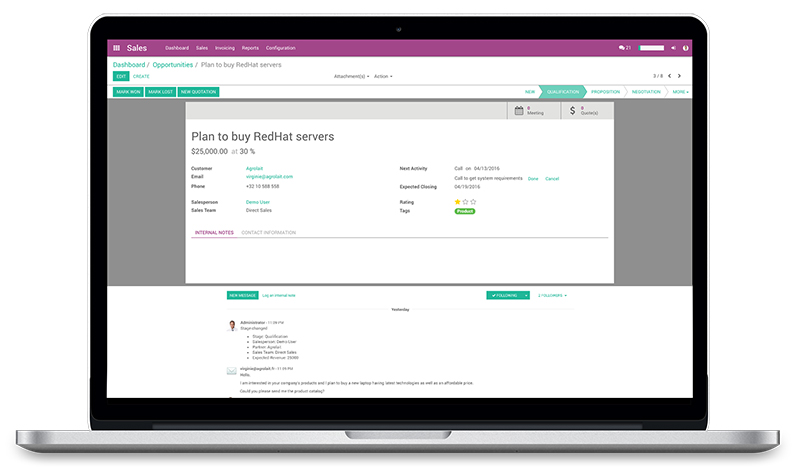CRM solutions on the market today
Any business, large or small, can have difficulty finding the CRM solution that fits the complex and unique needs of its sales team. Whether it's a SaaS solution or utilizing an internal server, implementing a CRM software requires a great deal of consideration as well as weighing many crucial and often interdependent factors.
The model of a modern business requires a powerful, dynamic, and cost-effective solution in order to keep a competitive edge against the competition. The right CRM choice will provide longevity in the effectiveness of its impact on daily operations, boosting the productivity of the sales team in a scalable way. In order to create a comparative analysis encompassing all the features that make optimizing efficiency and top-notch usability possible, we have created a feature comparison covering the many unique functionalities the top CRM competitors currently offer.

Salesforce
“ SELL SMARTER AND FASTER WITH THE WORLD'S #1 CRM. ”
The only free version of Salesforce is the “Developer Edition” which is limited in terms of data and number of users. Salesforce also provides 10 donated subscriptions and deep discounts to Nonprofit Organizations and higher education institutions.
Salesforce business solutions include Sales Cloud, Service Cloud, Marketing Cloud, Community Cloud, Wave Analytics, App Cloud, and IoT Cloud.
Four different pricing models and editions are available:
SalesforceIQ CRM Starter, Professional, Enterprise and Unlimited (all are billed monthly). For this comparison, we will select Salesforce Enterprise.
Odoo Online
“ GROW YOUR BUSINESS ”
Odoo is an open source software that is available in three versions, two of which are local while the other is hosted in the cloud. More than 7,300 apps are available thanks to the multiple developments made by Odoo S.A. and its community.
The cloud-based Online Edition of Odoo ERP offers a customized solution specifically designed to solve SME needs. In this highly modular solution, each business function is carried out by a dedicated app. This allows growing businesses to start with a few apps and to adopt more as their needs change and evolve.
For this comparison we’ve selected the cloud-hosted version, Odoo Online. The unique part of this offer is that it’s completely customizable. There are more than 30 certified apps that cover the vast majority of business cases, all of which connect to the same database on Odoo’s servers.
Features Comparison
CRM |
Salesforce |
Odoo Online |
|
|---|---|---|---|
| Leads Management | |||
| Leads Management | |||
| Leads Scoring | |||
| Deduplication | |||
| Sales Quotas | |||
| Leads Acquisition | |||
| Emails Integration | |||
| Contact Forms | |||
| Website Call-To-Action | |||
| Mass Import | |||
| Sales Pipeline | |||
| Opportunities Management | |||
| In-Pipeline Management 1 | |||
| Pipeline by Expected Closing Dates | |||
| Log Calls | |||
| Scripts/Automated Next Actions | |||
| Relationships | |||
| Companies | |||
| Contacts | |||
| Photos in Contacts | |||
| Multiple Contacts per Company | |||
| Multiple Companies per Contact | 2 | ||
Sales |
Salesforce |
Odoo Online |
|
|---|---|---|---|
| Quotations | |||
| Quotations | |||
| Pricelists | |||
| Quotation Templates | |||
| eSignature | |||
| Online Payment | |||
| Inline Negotiation | |||
| Multiple UoM | |||
| Sales Order | |||
| Sales Orders | |||
| Invoicing | |||
| Customer Portal | |||
| Shipper Integration (Cost+Tracking) | |||
| Subscriptions Management | |||
Marketing |
Salesforce |
Odoo Online |
|
|---|---|---|---|
| Leads Generation | |||
| Mass Mailing | |||
| Web to Leads Capture | |||
| Leads Tracking (Visited Pages) | |||
| Leads Nurturing | |||
| Events | |||
| Surveys | |||
| Blogs | |||
Reporting |
Salesforce |
Odoo Online |
|
|---|---|---|---|
| Reports | |||
| Activities Analysis | |||
| Pipeline Analysis | |||
| Sales Analysis | |||
| Invoice Analysis | |||
| Sales Forecasts | |||
| Commissions & Targets | |||
| Recurring Business 1 | |||
| Report Engine | |||
| Dynamic Graphs | |||
| Dynamic Pivot Table | |||
| Customizable Dashboard | |||
Productivity & Usability |
Salesforce |
Odoo Online |
|
|---|---|---|---|
| Productivity | |||
| VOIP Integration | |||
| Calendar Integration | |||
| Realtime Chat | |||
| Ability to Add Fields | |||
| Drag and Drop Fields | |||
| Social Network Integration | |||
| Emails | |||
| Email Integration | |||
| Email Templates | |||
| Users Satisfaction | |||
| Brand Visibility 1 | |||
| Usability | |||
| Full Web Interface | |||
| Mobile App | 2 | ||
| Android Offline App | |||
| iPhone Offline App | |||
| Multi-language | |||
| Interfaces | |||
| API | |||
| Apps Store | 1,000 Apps | 7,300 Apps 3 | |
User Interface
When it comes to efficiency and end-user satisfaction, fine-tuned usability is one of the most important factors in any software platform. In order to provide a strong value proposition, a CRM solution must take into account the needs and goals of its users in order to actively help them achieve their objectives. The user interface supports the overall product design in deciphering human factors such as preferences, habits, and learned skills in order to effectively serve the intended purpose of the software as it relates to the businesses that utilize it. A strongly functional design is critical in providing a positive user experience.
Usability is qualitatively measured as a software’s ability to anticipate what a user might need to do. This includes ensuring that all of the elements in the interface are easy to access, understand, and use. Well designed software will provide usability that helps the users feel comfortable with the system and obtaining their unique desired results. It will help users perform actions quickly and become more efficient in their day to day tasks. Best practices also suggest having a simple interface with consistency (common elements) and a page layout based on hierarchical importance and flow.
Ratings |
Salesforce |
Odoo Online |
|
|---|---|---|---|
| Subjective Ratings | |||
| Navigation and Search | |||
| Opportunities Pipeline | |||
| Mobile App | |||
| Reports Flexibility | |||
| Speed/Page Reloads 1 | |||
| User Satisfaction | |||
| Ratings on g2Crowd | 4.1 / 5 | 4.6 / 5 | |
| Ratings on GetApp | 3.9 / 5 | 5.0 / 5 | |
| Ratings on Capterra | 4.5 / 5 | 5.0 / 5 | |
The next section includes screenshots to help you compare the user interface, both in the list and form view, for each software in the comparison.
User Interface - Salesforce

Opportunities - Kanban View

Opportunities - Form View
User Interface - Odoo

Opportunities - Kanban View

Opportunities - Form View
Pricing & Conditions
Pricing & Conditions |
Salesforce |
Odoo Online |
|---|---|---|
| MONTHLY PRICING | $125/PER USER | Free 1 |
| Contract Duration | Yearly | n/a |
| Free Cloud Version | ||
| Free Trial | ||
| Free Updates | ||
| Upgrades to Future Versions | ||
| Hosting & Maintenance | ||
| Support | 2 |
Market Trends
The following graph was created with the Explore tool on Google Trends. The color curves show the number of Google searches for the associated keywords 1. This metric shows the relative consumer interest in each software platform.
Check by Yourself
Conclusion
Choosing and implementing a CRM solution is an important decision as well as a significant investment. It should be carefully considered with regards to your unique business needs and operations. If you are in the process of choosing a CRM solution, here are some points to consider before making your decision.
First, be sure to define your objectives. Examples of such objectives could be to get more leads, improve conversion rates, manage your sales teams, upsell to existing customers, etc. Secondly, what type of technology or support does your company prefer to work with? Do you prefer to maintain your software yourself via an on-premise server or utilize a cloud-hosted solution maintained by the software vendor? Additionally, what is your budget and internal competencies? On-premise solutions are preferred by large companies because they provide increased control of the platform and can assist in overcoming security concerns. Alternatively, online solutions are advisable for SME’s as the customization and costs (hosting, maintenance, implementation service, etc.) are usually minimal or even included in the base rate.
Once you have weighed the costs and benefits associated with these factors, your business can better analyze the potential solutions available on the market. When comparing the features of each solution, remember to consider the functional needs of the employees using the system in their daily operational tasks. Also, consider the business needs of decision makers in the organization; an optimal solution will support the efforts of all users.
Be sure to pay close attention to the usability of the system you choose. Simplicity contributes to a faster adoption of the software for users, and ultimately allows the salespeople in your organization to be more productive. In terms of usability, Pipedrive and Odoo allow for more advanced features to be learned and adopted quickly compared to the rest of the solutions on the market. Most CRM solutions offer a free trial, so it’s easy for businesses to test independently in just a few minutes.
As many CRM experts have mentioned, the future is mobile with integrated solutions supporting multi-channel sales and efficient communication. A mobile tool allows your employees to react quickly to customer requests while an integrated tool can seriously save time, empower users to operate more efficiently, and help maintain a clean, unified database.
Lastly, don’t forget to look at the big picture. If a company’s long-term goal is to grow its sales volume, the best approach to choosing a CRM solution is to start with a solution that can follow that growth over time. To accomplish this, a flexible solution with robust features that can offer tools which work in tandem with the CRM to manage the business would be the ideal choice for a scaleable and cost-effective solution.